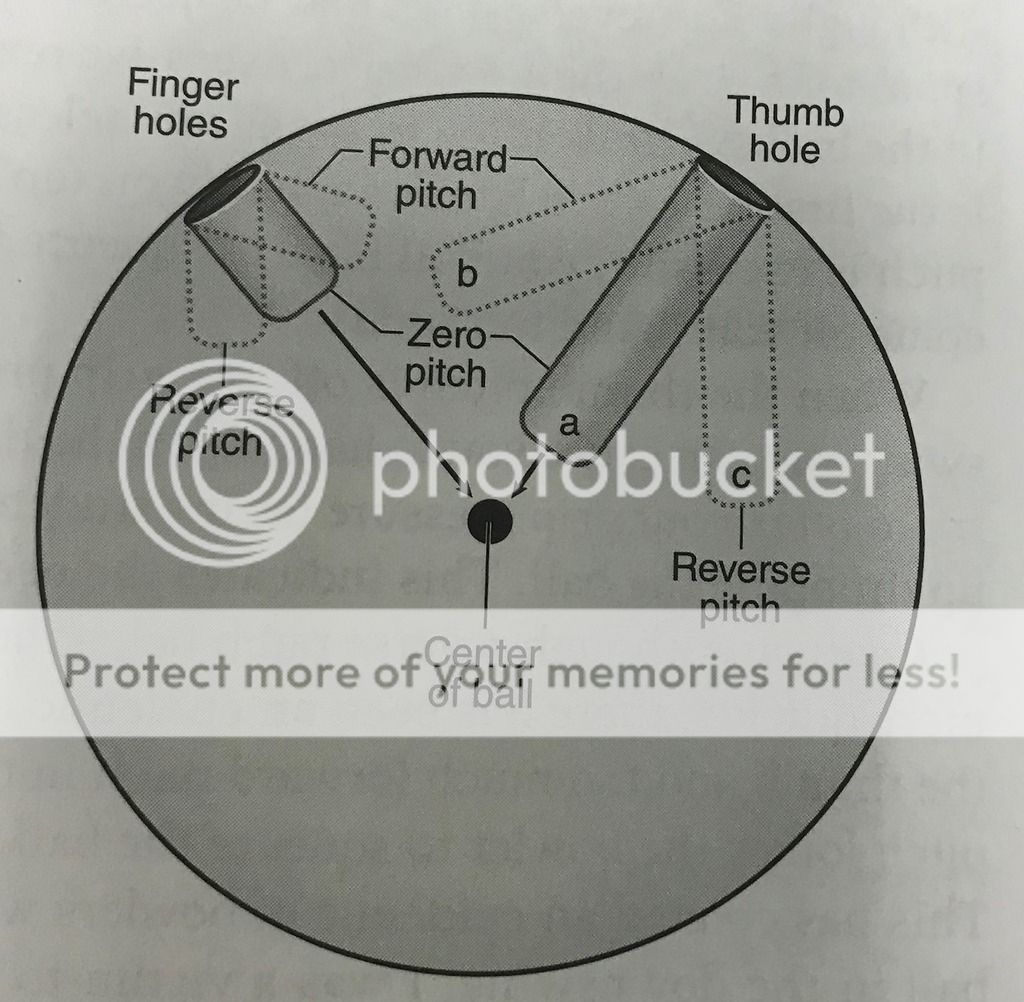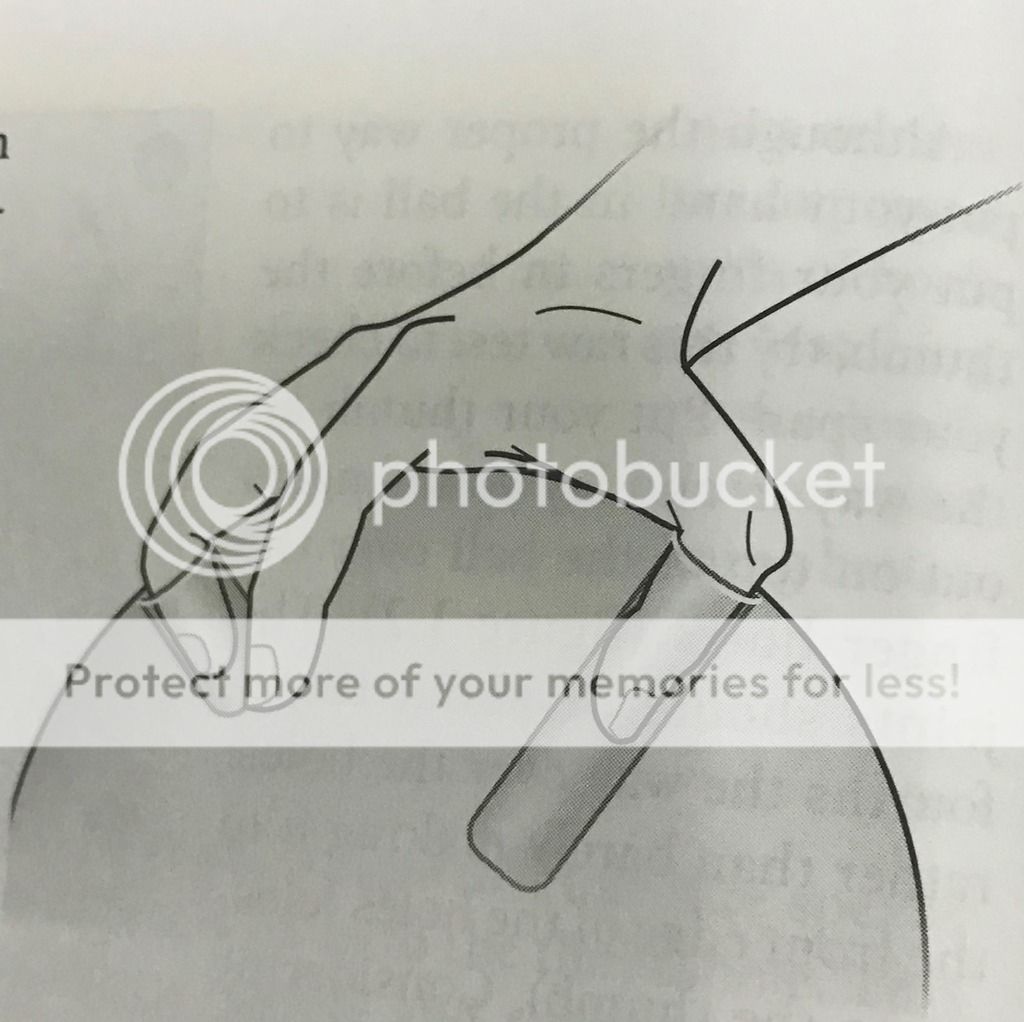Ball Fit
Written By: bowlingball.com | Written On: Wednesday, October 2, 2024
Excerpt from Bowling Fundamentals - Second Edition By Michelle Mullen: Updated 10/02/2024 by bowlingball.com
9/9/2018
There are three aspects to ball fit: hole size, span and pitch. Hole size speaks for itself. The span is the distance from the finger holes to the thumbhole. This is carefully measured to ensure that both the fingers and the thumb insert securely at the joints. Finally, the pitches are the angles at which the holes are drilled into the ball. Proper pitches are very important and are based on flexibility and hand span.
HOLE SIZE:
Having proper size holes (see photo) is important. You should be able to get your fingers and thumb in all the way, without the holes being so large that you need to squeeze the ball to keep it on your hand. The holes should provide a snug fit, but they shouldn't be so tight that you cannot get your fingers or thumb in all the way. Hole shape also is a consideration for a good fit. The thumbhole can be drilled to accommodate the shape of your thumb, whether it's thicker on the sides, has an oval shape, or any other quality. This allows you to keep the thumbhole snug while preventing any unnecessary friction on release.

SPAN:
The span is the distance between the finger holes and the thumbhole. Your hand has to be carefully and skillfully measured for span. With a proper span, you can get both your fingers and your thumb in all the way with ease. If you have to stretch your hand to get your fingers and thumb in all the way, or if you have to choose between one or the other, the span is likely too long. At the same time, you do not want the holes so close that there is a lot of space between the ball and your palm. A span that is too long or too short will cause you to squeeze the ball.
Although the proper way to put your hand in the ball is to put your finger in before the thumb, try this raw test to check your span. Put your thumb all the way in and lay your fingers out on top of the ball over the finger holes. The joints should be about three-fourths the way over the holes, rather than barely making it to the front edge of the holes (closest to the thumb). Considering how your fingers line up with the holes in a straight line allows you to properly gauge if you will be able to properly reach the span once your fingers are inserted.
PITCH:
Pitch (see photo) is the angle at which a hole is drilled into the ball. When the hole is drilled directly toward the center of the ball, the hole is considered to have no angle or zero pitch. A hole drilled at an angle in either direction away from the center of the ball has pitch, either forward or reverse. Forward pitch is a hole drilled on an angle toward the palm of the hand. Reverse pitch is a hole drilled away from the palm. A gauge is used to measure pitches.
Forward pitch provides a more secure fit to help you hold on to the ball. Reverse pitch helps you release it sooner. The proper pitches for you depend on your span and flexibility. Again, your hand has to be carefully and skillfully measured to determine the amount of pitch you need in each hole.
Generally, the shorter the span is, the more help you need holding on to the ball, so forward pitch is necessary. That is why forward pitches on both the finger holes and thumb hole are necessary with a conventional span for proper grip pressure. The amount will further depend on your flexibility.

THUMB PITCH AND BACKSWING:
Although some reverse pitch may be necessary (depending on your skill level and span) for a clean thumb release, excessive reverse pitch leads to excess gripping in the backswing, leading to swing and release issues. The top of the backswing is the first time your hand is actually on top of the ball during the swing. If the pitch is excessive, you will have to squeeze it at that point so the ball does not come off your hand too soon.
When the thumb pitch is off, the grip pressure forces you to tighten up the swing and can cause you to hand up in the thumb at release. But then, when you try to relax your grip pressure (as my students often do during lessons), you end up dropping the ball. This indicates the need for a different pitch.
Caution: Although reverse pitch helpd the bowler clear the thumbhole a little more quickly, there has been an epidemic of putting too much reverse pitch in the thumb and too much forward pitch in the fingers. Excessive reverse thumb pitch forces the bowler to squeeze the ball to keep it on the hand long enough. This has created an epidemic of bowlers who end up grabbing and pulling the ball in the downswing. I was a victim of this for years! There is a difference between having enough reverse pitch in the thumb so you can get it out of the ball clean and having so much pitch that you have to squeeze so that your thumb doesnt't come out too soon. Fortunately, through a better understanding of progressive fitting techniques, we've been able to help many bowlers get rid of or even avoid this problem.
FINGERTIP PITCHES AND FLEXIBILITY:
With some exceptions, most players who use a fingertip grip need some reverse pitch to accommodate the lack of flexibility in their fingertip joints. In a fingertip grip, the hand is spread across a longer span, which requires more joint flexibility to bend the fingers forward and have the finger pads flush against the front of the finger holes. Reverse pitch helps the bowler achieve this feel. It used to be common to drill the finger holes forward to try to create lift on the ball. But that was when the balls were much weaker and needed more action. Now, with much stronger bowling balls that naturally hook more, you want to release the ball more cleanly off your hand and roll it into the lane for the best reaction. Although many bowlers still refer to the concept of lifting the ball, I haven't taught it since I've been coaching!

Mullen, Michelle. Bowling Fundamentals- Second Edition. Champaign, IL: Human Kinetics, 2014.
Here is a detailed update from the team at bowlingball.com:
Determining if you have a good bowling ball fit is essential for both comfort and performance. A well-fitted ball will allow for better control, accuracy, and reduce the risk of injury. Here’s how to tell if your bowling ball is properly fitted:
1. Finger Grip Fit
Your fingers should slide easily in and out of the holes without sticking, but the fit should also not be too loose. If your fingers feel pinched or overly tight, the holes are too small. If they slip too easily and lack control, they’re too large.
Depending on the grip style:
For a conventional grip (where your fingers go in up to the second knuckle), your hand should feel relaxed and not stretched.
For a finger-tip grip (where fingers go in only up to the first knuckle), there should be enough tension to give you control without strain.
When you release the ball, your fingers should come out smoothly without sticking or discomfort. If they catch or twist, the fit may be off.
2. Thumb Hole Fit
The thumb hole should feel snug but comfortable. You should be able to slide your thumb in and out without gripping the ball tightly. A proper fit allows your thumb to exit cleanly at the release point.
Ensure there are no pressure points that cause discomfort. If your thumb feels pinched, the hole might be too tight, and if it slips too easily, it's too loose.
3. Span Fit (Distance Between Finger Holes and Thumb Hole)
The span, or distance between your finger holes and the thumb hole, should allow your hand to lay naturally over the ball without feeling stretched or cramped. For a conventional grip, when your fingers are fully inserted, your hand should remain relaxed. In a finger-tip grip, your hand should curve naturally, with enough tension to control the ball but not so much that your hand feels overextended.
Place your thumb in the thumb hole and lay your fingers over the finger holes. The pads of your fingers should comfortably rest over the holes without pulling or forcing them to stretch.
4. Weight of the Ball
The ball should feel heavy enough to generate momentum but light enough that you can swing it without strain. A good rule of thumb is to choose a ball that’s about 10% of your body weight, but ultimately, it should be comfortable to hold and control throughout the game.
You should be able to maintain control of the ball during the release without having to grip it too tightly, which can affect your performance and cause fatigue.
5. Hand Positioning and Flexibility
When holding the ball, your hand should be in a natural, relaxed position. If you feel the need to adjust your grip constantly or twist your wrist unnaturally, it may indicate that the fit is off.
Your wrist and forearm should also feel relaxed. If you feel any strain in your wrist or forearm after releasing the ball, it could be a sign of poor fit, especially in the span or weight.
6. Avoiding Calluses and Blisters
A properly fitted bowling ball should not cause blisters, calluses, or bruising on your fingers or thumb. If you're experiencing pain, especially on the sides of your fingers or thumb, it’s likely that the finger or thumb holes are incorrectly sized or the span is too short or too long.
If you're gripping too tightly to maintain control, you may develop discomfort. A good fit should allow for a relaxed grip and a smooth, controlled release.
7. Professional Fitting
The best way to ensure you have a perfect fit is to get your ball professionally fitted at a pro shop. Experts can measure your hand precisely and customize the ball’s holes, span, and weight to match your unique needs. They can also watch your release and make adjustments if necessary.
By ensuring your bowling ball fits properly in all these areas, you’ll have better control, improved performance, and a more enjoyable experience on the lanes.

